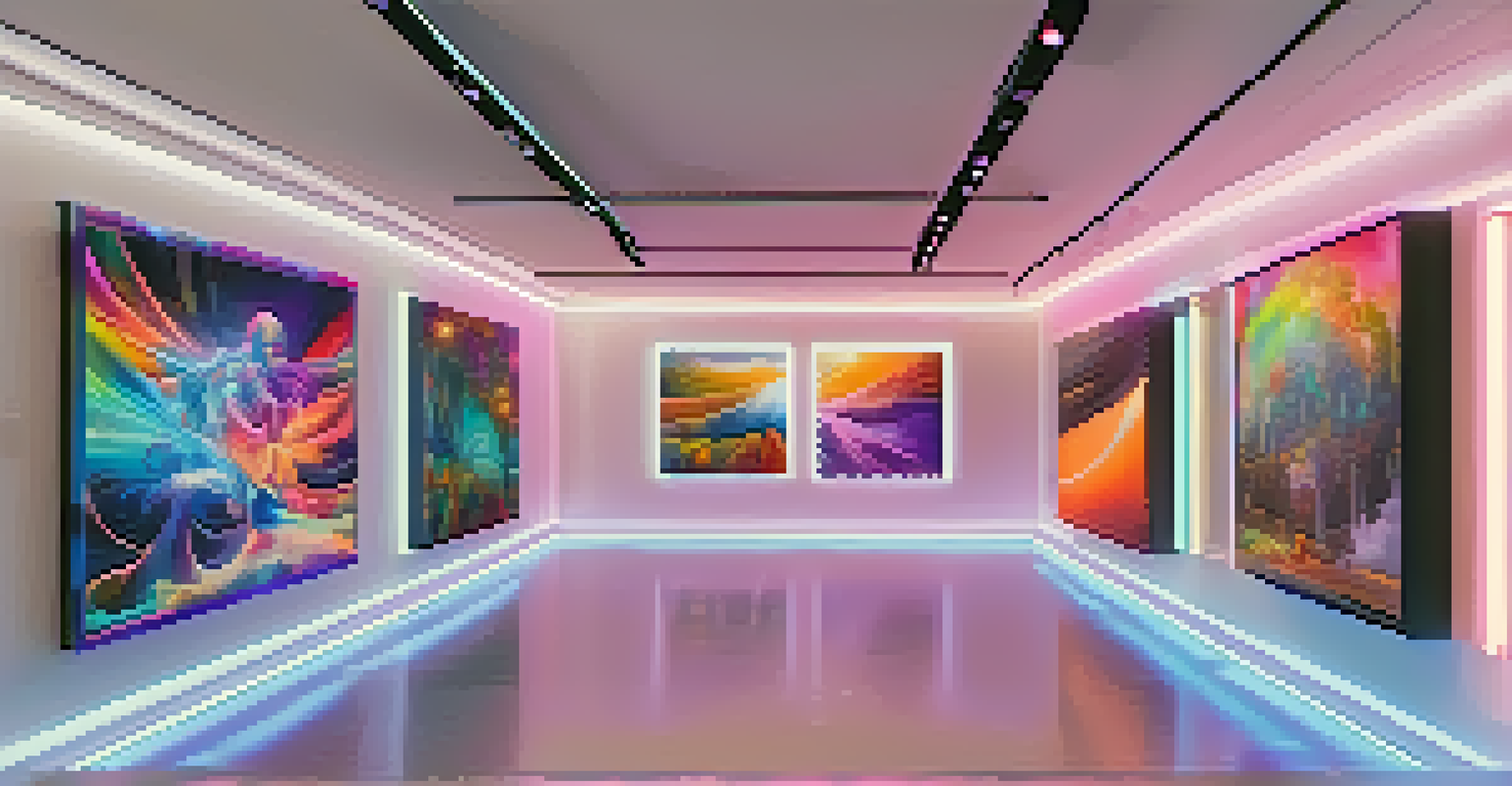Creating and Selling Digital Art: Ethereum's New Paradigm

Understanding Digital Art and NFTs in Ethereum's Ecosystem
Digital art has taken the world by storm, allowing artists to create and share their work in innovative ways. With the advent of Non-Fungible Tokens (NFTs), each piece of digital art can be uniquely owned, similar to owning a rare painting. Ethereum, being a leading blockchain for NFTs, provides a platform where artists can register their work, ensuring authenticity and ownership.
Digital art is not just a medium; it’s a movement that empowers creators to share their vision with the world.
NFTs function like digital certificates of authenticity, enabling artists to sell their work directly to collectors without intermediaries. This shift not only empowers creators but also opens up new revenue streams. Imagine selling a digital piece and knowing that every resale can generate royalties for you as the original artist!
As more artists explore this medium, the potential for creativity and community-building expands. Artists can connect with buyers around the globe, fostering a new era of art appreciation. Understanding this ecosystem is crucial for anyone looking to dive into the world of digital art on Ethereum.
Setting Up Your Digital Art Portfolio on Ethereum
Creating a digital art portfolio on Ethereum begins with choosing a wallet that supports cryptocurrencies and NFTs. Popular options like MetaMask or Coinbase Wallet allow you to store your digital assets securely while giving you access to various marketplaces. Think of your wallet as your digital art gallery; it’s where your creations and purchases are kept.

Once your wallet is set up, you can mint your art into NFTs on platforms like OpenSea or Rarible. Minting is the process of turning your digital files into NFTs, which then become part of the blockchain. It’s similar to publishing a book; once it’s out there, it can be bought, sold, or traded.
NFTs Empower Digital Artists
Non-Fungible Tokens (NFTs) enable artists to uniquely own and sell their digital art, creating new revenue opportunities.
Having a well-organized portfolio not only showcases your work but also builds your brand as an artist. It’s essential to present your art in a way that resonates with potential buyers, highlighting your unique style and story. This initial step lays the groundwork for a successful venture into the digital art realm.
Creating Unique Digital Art That Sells
Creating digital art that stands out in a crowded market is both an art and a science. Start by developing a unique style that reflects your personality and resonates with your audience. Whether it’s vibrant colors, intricate designs, or thought-provoking themes, your art should tell a story that captivates viewers.
The future belongs to those who believe in the beauty of their dreams.
Additionally, consider current trends in the digital art world. Themes like nature, technology, and social issues often attract attention. By infusing these elements into your work, you can tap into what’s popular while still keeping your personal touch.
Moreover, engaging with your audience through social media can provide insights into what resonates with them. Sharing behind-the-scenes content, sketches, or your creative process can foster a connection that makes your art more appealing. After all, people love to support artists they feel a connection with!
Navigating the NFT Marketplaces for Selling Art
Once your digital art is minted as an NFT, the next step is to navigate the various marketplaces to sell it. Platforms like OpenSea, Rarible, and Foundation each have unique features and audiences. It’s like choosing the right art gallery for your work; the right fit can significantly impact your sales.
Consider the fees associated with each platform, as they can vary widely. Some platforms charge listing fees, while others take a percentage of the sale. Understanding these costs helps you price your art appropriately, ensuring you earn a fair return.
Building Your Digital Portfolio
Setting up a digital art portfolio on Ethereum involves choosing the right wallet and minting art into NFTs to showcase and sell.
Additionally, pay attention to the community and engagement on these platforms. A marketplace with an active user base can lead to more visibility for your art. By participating in community events or collaborations, you can enhance your presence and attract potential buyers.
Marketing Your Digital Art Effectively
Marketing is a crucial aspect of selling digital art, especially in the competitive NFT space. Utilize social media platforms like Instagram, Twitter, and TikTok to showcase your art and connect with followers. Think of it as hosting a virtual exhibition; your posts should invite viewers to engage with your work.
Consider creating a personal brand that reflects your artistic style and values. Consistent messaging and visual elements across your platforms help establish recognition. Crafting a compelling artist bio and sharing your journey can also draw people in, making them more likely to support your work.
Collaboration with other artists or influencers can amplify your reach. By participating in joint projects or taking part in online events, you can tap into new audiences. Remember, marketing isn’t just about selling; it’s about building relationships and fostering a community around your art.
Understanding Copyright and Ownership in Digital Art
As a digital artist, understanding copyright and ownership is essential for protecting your work. When you mint an NFT, you retain the copyright, meaning you still own the original rights to your art. However, buyers purchase the token, which grants them ownership of that specific digital item.
It’s important to clearly communicate the terms of your sale. For instance, will the buyer have the right to display your art, or are there restrictions on commercial use? Clear guidelines help prevent misunderstandings and ensure both parties are on the same page.
Effective Marketing Strategies
Utilizing social media and collaborations can significantly enhance visibility and engagement for digital artists in the competitive NFT market.
Educating yourself on copyright laws can also safeguard you against potential infringement. Knowledge about how to enforce your rights can empower you as an artist. In a world where digital art can be easily copied, understanding these nuances is more important than ever.
Future Trends in Digital Art and NFTs on Ethereum
The future of digital art and NFTs on Ethereum is an exciting frontier, with new trends emerging regularly. One growing trend is the integration of augmented reality (AR) and virtual reality (VR), allowing collectors to experience art in immersive ways. Imagine showcasing your art in a virtual gallery where viewers can walk through and interact with your pieces!
Moreover, the concept of community-driven art projects is gaining traction. Artists are collaborating with their audiences to create pieces together, blending individual creativity into collective works. This trend not only enhances engagement but also fosters a sense of ownership among participants.

As technology evolves, so too will the possibilities for digital artists. Staying informed about developments in blockchain technology, digital tools, and art trends will ensure you remain relevant in this dynamic space. Embracing change and innovation can lead to exciting opportunities in your artistic journey.